by Calculated Risk on 1/09/2022 09:55:00 AM
Sunday, January 09, 2022
Lawler: More on Investor Purchases of Single-Family Homes
Today, in the Calculated Risk Real Estate Newsletter: Lawler: More on Investor Purchases of Single-Family Homes
A brief excerpt:
From housing economist Tom Lawler:There is much more in the article. You can subscribe at https://calculatedrisk.substack.com/
Recent reports showing a surge in investor purchases of single-family homes beginning last spring has stunned quite a few housing analysts and led several to reassess the “drivers” of the surprising strength in housing and home prices this year.
One of the reports I’m referring to is from Redfin, and the other is from CoreLogic. While both are based on an analysis of property records, there are key differences.
Before going into some of the potential ramifications of this investor surge, however, I thought it might be useful to discuss these reports – especially in light of a recent “research” report from the trade association “dedicated to advocating on behalf of the single-family rental industry” that completed botched its analysis of these recent reports.
Saturday, January 08, 2022
Real Estate Newsletter Articles this Week
by Calculated Risk on 1/08/2022 02:11:00 PM
At the Calculated Risk Real Estate Newsletter this week:
• Rents Still Increasing Sharply Year-over-year
• 1st Look at Local Housing Markets in December
• Apartment Vacancy Rate Declined in Q4
• Will the unprecedented surge in investor purchases of Single Family homes continue?
This is usually published several times a week, and provides more in-depth analysis of the housing market.
You can subscribe at https://calculatedrisk.substack.com/ Most content is available for free, but please subscribe!.
Schedule for Week of January 9, 2022
by Calculated Risk on 1/08/2022 08:11:00 AM
The key reports this week are December CPI and retail sales.
For manufacturing, the December Industrial Production report will be released.
No major economic releases scheduled.
6:00 AM: NFIB Small Business Optimism Index for December.
10:00 AM: Testimony, Fed Chair Jerome Powell, Nomination Hearing, Before the Committee on Banking, Housing, and Urban Affairs, U.S. Senate
7:00 AM ET: The Mortgage Bankers Association (MBA) will release the results for the mortgage purchase applications index.
8:30 AM: The Consumer Price Index for December from the BLS. The consensus is for 0.5% increase in CPI, and a 0.5% increase in core CPI.
8:30 AM: The initial weekly unemployment claims report will be released. The consensus is for 210 thousand initial claims.
8:30 AM ET: The Producer Price Index for December from the BLS. The consensus is for a 0.4% increase in PPI, and a 0.5% increase in core PPI.
10:00 AM, Testimony, Fed Governor Lael Brainard, Nomination Hearing, Before the Committee on Banking, Housing, and Urban Affairs, U.S. Senate
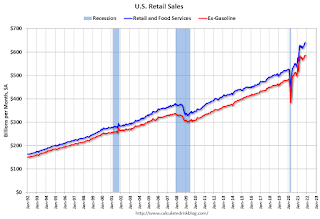 8:30 AM: Retail sales for December is scheduled to be released. The consensus is for a 0.1% decrease in retail sales.
8:30 AM: Retail sales for December is scheduled to be released. The consensus is for a 0.1% decrease in retail sales.This graph shows retail sales since 1992. This is monthly retail sales and food service, seasonally adjusted (total and ex-gasoline).
 9:15 AM: The Fed will release Industrial Production and Capacity Utilization for December.
9:15 AM: The Fed will release Industrial Production and Capacity Utilization for December.This graph shows industrial production since 1967.
The consensus is for a 0.3% increase in Industrial Production, and for Capacity Utilization to increase to 77.0%.
10:00 AM: University of Michigan's Consumer sentiment index (Preliminary for January).
Friday, January 07, 2022
COVID Update Jan 7, 2022
by Calculated Risk on 1/07/2022 09:40:00 PM
On COVID (focus on hospitalizations and deaths):
| COVID Metrics | ||||
|---|---|---|---|---|
| Today | Week Ago | Goal | ||
| Percent fully Vaccinated | 62.4% | --- | ≥70.0%1 | |
| Fully Vaccinated (millions) | 207.2 | --- | ≥2321 | |
| New Cases per Day3🚩 | 614,552 | 360,566 | ≤5,0002 | |
| Hospitalized3🚩 | 99,690 | 70,676 | ≤3,0002 | |
| Deaths per Day3🚩 | 1,350 | 1,136 | ≤502 | |
| 1 Minimum to achieve "herd immunity" (estimated between 70% and 85%). 2my goals to stop daily posts, 37-day average for Cases, Currently Hospitalized, and Deaths 🚩 Increasing 7-day average week-over-week for Cases, Hospitalized, and Deaths ✅ Goal met. | ||||
 Click on graph for larger image.
Click on graph for larger image.This graph shows the daily (columns) and 7-day average (line) of positive tests reported.
AAR: December Rail Carloads Down Compared to 2019; Intermodal Up
by Calculated Risk on 1/07/2022 05:01:00 PM
From the Association of American Railroads (AAR) Rail Time Indicators. Graphs and excerpts reprinted with permission.
U.S. rail carloads totaled 12.01 million in 2021, up 6.6% over 2020 but down 7.4% from 2019. ...
For intermodal, 2021 was the tale of two halves. The first six months of 2021 saw record-breaking highs, but volume cooled in the second half as global supply chain challenges persisted. For all of 2021, U.S. railroads originated 14.14 million containers and trailers — up 5.1% over 2020, up 3.4% over 2019, and the second most ever for a full year. Only 2018’s 14.47 million was higher.
emphasis added
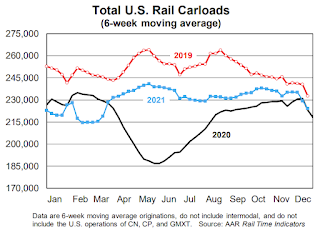 Click on graph for larger image.
Click on graph for larger image.This graph from the Rail Time Indicators report shows the six week average of U.S. Carloads in 2019, 2020 and 2021:
U.S. railroads originated 1.14 million total carloads in December 2021, up 3.1% over December 2020 and down 0.7% from December 2019. December was the tenth straight overall year-over-year gain and the fifth straight in the 2%-4% range.
 The second graph shows the six week average (not monthly) of U.S. intermodal in 2019, 2020 and 2021: (using intermodal or shipping containers):
The second graph shows the six week average (not monthly) of U.S. intermodal in 2019, 2020 and 2021: (using intermodal or shipping containers):Meanwhile, U.S. railroads originated 1.22 million intermodal containers and trailers in December 2021, down 8.2% from December 2020 and the fifth straight year-over-year decline. Volume averaged 244,956 units per week in December 2021, the fewest since May 2020. (December is typically one of the lowest-volume intermodal months of the year.)
Q4 GDP Forecasts: Moving Down
by Calculated Risk on 1/07/2022 03:23:00 PM
From BofA:
Our forecast for retail sales to contract in December led us to lower our 4Q GDP tracking estimate down to 5.5% qoq saar from 6.0% previously. [January 7 estimate]From Goldman Sachs:
emphasis added
We left our Q4 GDP tracking estimate unchanged at +7.0% (qoq ar). [January 6 estimate]And from the Altanta Fed: GDPNow
The GDPNow model estimate for real GDP growth (seasonally adjusted annual rate) in the fourth quarter of 2021 is 6.7 percent on January 6, down from 7.4 percent on January 4. [January 6 estimate]
Hotels: Occupancy Rate Down "Slightly" Compared to Same Week in 2019
by Calculated Risk on 1/07/2022 02:28:00 PM
U.S. hotel demand for the week between the Christmas and New Year’s Eve holidays was the highest ever recorded, and hoteliers capitalized, charging record-high weekly rates.The following graph shows the seasonal pattern for the hotel occupancy rate using the four week average.
Christmas Day hotel occupancy also set a record in the U.S. at 47.3%; the previous peak was 47%, reached in 2015. New Year’s Eve hotel performance was likely limited by the rise in COVID-19 cases linked to the omicron variant, which resulted in limitations or outright cancellations of many large-scale celebrations. Occupancy on that day rose to 62%, which was higher than in 2019 (59.4%), but well below the peak set in 2016 (68.7%).
Occupancy for the seven-day period between Christmas Day and New Year’s Eve was 53.7%, which also was not a record and slightly below the level achieved in 2019.
emphasis added
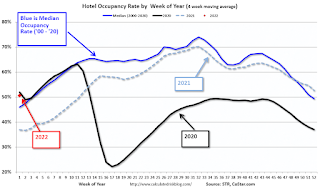 Click on graph for larger image.
Click on graph for larger image.The red dot is for 2022, black is 2020, blue is the median, and dashed light blue is for 2021.
Rents Still Increasing Sharply Year-over-year
by Calculated Risk on 1/07/2022 12:44:00 PM
Today, in the Calculated Risk Real Estate Newsletter: Rents Still Increasing Sharply Year-over-year
A brief excerpt:
Here is a graph of the year-over-year (YoY) change for these measures since January 2015. All of these measures are through November 2021 (Apartment List through December).There is much more in the article. You can subscribe at https://calculatedrisk.substack.com/
...
The Zillow measure is up 12.6% YoY in November, up from 12.0% YoY in October. And the ApartmentList measure is up 17.8% as of December, up from 17.7% in November. Both the Zillow measure (a repeat rent index), and ApartmentList are showing a sharp increase in rents.
Clearly rents are increasing sharply, and we should expect this to continue to spill over into measures of inflation in 2022. The Owners’ Equivalent Rent (OER) was up 3.5% YoY in November, from 3.1% in November - and will increase further in the coming months.
Comments on December Employment Report
by Calculated Risk on 1/07/2022 11:00:00 AM
The headline jobs number in the December employment report was below expectations, however, employment for the previous two months was revised up by 141,000. The participation rate was unchanged, the employment-population ratio increased, and the unemployment rate decreased to 3.9%.
Earlier: December Employment Report: 199 thousand Jobs, 3.9% Unemployment Rate
In December, the year-over-year employment change was 6.45 million jobs, making 2021 the best year ever for job growth.
Permanent Job Losers
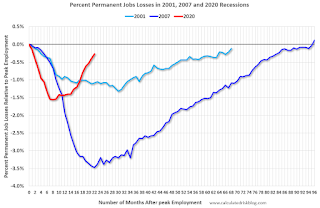 Click on graph for larger image.
Click on graph for larger image.This graph shows permanent job losers as a percent of the pre-recession peak in employment through the report today. (ht Joe Weisenthal at Bloomberg).
In December, the number of permanent job losers decreased to 1.703 million from 1.905 million in November.
Prime (25 to 54 Years Old) Participation
 Since the overall participation rate has declined due to cyclical (recession) and demographic (aging population, younger people staying in school) reasons, here is the employment-population ratio for the key working age group: 25 to 54 years old.
Since the overall participation rate has declined due to cyclical (recession) and demographic (aging population, younger people staying in school) reasons, here is the employment-population ratio for the key working age group: 25 to 54 years old.The prime working age will be key as the economy recovers.
The 25 to 54 participation rate was unchanged in December at 81.9% from 81.9% in November, and the 25 to 54 employment population ratio increased to 79.0% from 78.8% the previous month.
Seasonal Retail Hiring
Typically, retail companies start hiring for the holiday season in October, and really increase hiring in November. Here is a graph that shows the historical net retail jobs added for October, November and December by year.
 This graph really shows the collapse in retail hiring in 2008. Since then, seasonal hiring had increased back close to more normal levels. Note: I expect the long-term trend will be down with more and more internet holiday shopping.
This graph really shows the collapse in retail hiring in 2008. Since then, seasonal hiring had increased back close to more normal levels. Note: I expect the long-term trend will be down with more and more internet holiday shopping.Retailers hired 104 thousand workers Not Seasonally Adjusted (NSA) net in December.
Part Time for Economic Reasons
 From the BLS report:
From the BLS report:"The number of persons employed part time for economic reasons, at 3.9 million in December, decreased by 337,000 over the month. The over-the-year decline of 2.2 million brings this measure to 461,000 below its February 2020 level. These individuals, who would have preferred full-time employment, were working part time because their hours had been reduced or they were unable to find full-time jobs."The number of persons working part time for economic reasons decreased in December to 3.929 million from 4.466 million in November. This is at pre-recession levels.
These workers are included in the alternate measure of labor underutilization (U-6) that decreased to 7.3% from 7.7% in the previous month. This is down from the record high in April 22.9% for this measure since 1994. This measure was at 7.0% in February 2020 (pre-pandemic).
Unemployed over 26 Weeks
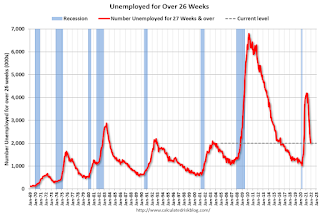 This graph shows the number of workers unemployed for 27 weeks or more.
This graph shows the number of workers unemployed for 27 weeks or more. According to the BLS, there are 2.008 million workers who have been unemployed for more than 26 weeks and still want a job, down from 2.193 million the previous month.
This does not include all the people that left the labor force.
Summary:
The headline monthly jobs number was below expectations; however, the previous two months were revised up by 141,000 combined. This was the most jobs added in a single calendar year ever (6.45 million), but not as a percent of the labor force (that happened after WWII).
December Employment Report: 199 thousand Jobs, 3.9% Unemployment Rate
by Calculated Risk on 1/07/2022 08:47:00 AM
From the BLS:
Total nonfarm payroll employment rose by 199,000 in December, and the unemployment rate declined to 3.9 percent, the U.S. Bureau of Labor Statistics reported today. Employment continued to trend up in leisure and hospitality, in professional and business services, in manufacturing, in construction, and in transportation and warehousing.
...
The change in total nonfarm payroll employment for October was revised up by 102,000, from +546,000 to +648,000, and the change for November was revised up by 39,000, from +210,000 to +249,000. With these revisions, employment in October and November combined is 141,000 higher than previously reported.
emphasis added
 Click on graph for larger image.
Click on graph for larger image.The first graph shows the year-over-year change in total non-farm employment since 1968.
In December, the year-over-year change was 6.45 million jobs. This was up significantly year-over-year.
Total payrolls increased by 199 thousand in December. Private payrolls increased by 211 thousand, and public payrolls declined 12 thousand.
Payrolls for October and November were revised up 141 thousand, combined.
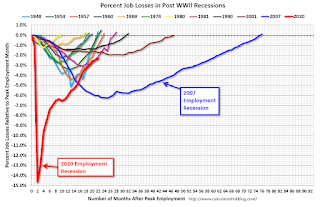 The second graph shows the job losses from the start of the employment recession, in percentage terms.
The second graph shows the job losses from the start of the employment recession, in percentage terms.The current employment recession was by far the worst recession since WWII in percentage terms. However, the current employment recession, 22 months after the onset, is now significantly better than the worst of the "Great Recession".
The third graph shows the employment population ratio and the participation rate.
 The Labor Force Participation Rate was unchanged at 61.9% in December, from 61.9% in November. This is the percentage of the working age population in the labor force.
The Labor Force Participation Rate was unchanged at 61.9% in December, from 61.9% in November. This is the percentage of the working age population in the labor force. The Employment-Population ratio increased to 59.5% from 59.3% (blue line).
I'll post the 25 to 54 age group employment-population ratio graph later.
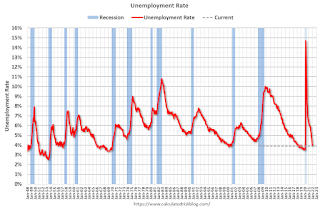 The fourth graph shows the unemployment rate.
The fourth graph shows the unemployment rate. The unemployment rate decreased in December to 3.9% from 4.2% in November.
This was well below consensus expectations; however, October and November were revised up by 141,000 combined.
Thursday, January 06, 2022
Friday: Employment Report
by Calculated Risk on 1/06/2022 07:23:00 PM
My December Employment Preview
Goldman December Payrolls Preview
Friday:
• At 8:30 AM ET, Employment Report for December. There were 120 thousand jobs added in November, and the unemployment rate was at 4.2%. The consensus is for 400 thousand jobs added in December, and for the unemployment rate to decline to 4.1%.
And on COVID (focus on hospitalizations and deaths):
| COVID Metrics | ||||
|---|---|---|---|---|
| Today | Week Ago | Goal | ||
| Percent fully Vaccinated | 62.4% | --- | ≥70.0%1 | |
| Fully Vaccinated (millions) | 207.0 | --- | ≥2321 | |
| New Cases per Day3🚩 | 586,391 | 315,851 | ≤5,0002 | |
| Hospitalized3🚩 | 95,250 | 67,842 | ≤3,0002 | |
| Deaths per Day3🚩 | 1,245 | 1,088 | ≤502 | |
| 1 Minimum to achieve "herd immunity" (estimated between 70% and 85%). 2my goals to stop daily posts, 37-day average for Cases, Currently Hospitalized, and Deaths 🚩 Increasing 7-day average week-over-week for Cases, Hospitalized, and Deaths ✅ Goal met. | ||||
 Click on graph for larger image.
Click on graph for larger image.This graph shows the daily (columns) and 7-day average (line) of positive tests reported.
Goldman December Payrolls Preview
by Calculated Risk on 1/06/2022 03:59:00 PM
A few brief excerpts from a note by Goldman Sachs economist Spencer Hill:
We estimate nonfarm payrolls rose 500k, above consensus of +444k. ... We estimate a one-tenth drop in the unemployment rate to 4.1%.CR Note: The consensus is for 400 thousand jobs added, and for the unemployment rate to decrease to 4.1%.
emphasis added
1st Look at Local Housing Markets in December
by Calculated Risk on 1/06/2022 01:13:00 PM
Today, in the Calculated Risk Real Estate Newsletter: 1st Look at Local Housing Markets in December
A brief excerpt:
And a table of December sales. Sales were down 11.1% YoY, Not Seasonally Adjusted (NSA).There is much more in the article. You can subscribe at https://calculatedrisk.substack.com/
Note that there was one fewer selling day in December ‘21 compared to December ‘20, so the Seasonally Adjusted (SA) number will show less of a YoY decline than the NSA numbers.
December Employment Preview
by Calculated Risk on 1/06/2022 10:53:00 AM
On Friday at 8:30 AM ET, the BLS will release the employment report for December. The consensus is for 400 thousand jobs added, and for the unemployment rate to decrease to 4.1%.
 Click on graph for larger image.
Click on graph for larger image.• First, currently there are still about 3.9 million fewer jobs than in February 2020 (before the pandemic).
This graph shows the job losses from the start of the employment recession, in percentage terms.
The current employment recession was by far the worst recession since WWII in percentage terms. However, the current employment recession, 20 months after the onset, is now significantly better than the worst of the "Great Recession".
• ADP Report: The ADP employment report showed a gain of 807,000 private sector jobs, well above the consensus estimate of 413,000 jobs added. The ADP report hasn't been very useful in predicting the BLS report, but this suggests the BLS report could be above expectations.
• ISM Surveys: Note that the ISM services are diffusion indexes based on the number of firms hiring (not the number of hires). The ISM® manufacturing employment index increased in December to 54.2%, up from 53.3% last month. This would suggest little change in manufacturing employment in December. ADP showed 74,000 manufacturing jobs added.
The ISM® Services employment index decreased in December to 54.9%, down from 56.5% last month. This would suggest a 200 thousand increase in service employment in December. Combined, the ISM indexes suggest employment below the consensus estimate.
• Unemployment Claims: The weekly claims report showed a decline in the number of initial unemployment claims during the reference week (includes the 12th of the month) from 270,000 in November to 206,000 in December. This would usually suggest fewer layoffs in December than in November, although this might not be very useful right now. In general, weekly claims have been falling, and have been below expectations in December.
 • Permanent Job Losers: Something to watch in the employment report will be "Permanent job losers". This graph shows permanent job losers as a percent of the pre-recession peak in employment through the November report.
• Permanent Job Losers: Something to watch in the employment report will be "Permanent job losers". This graph shows permanent job losers as a percent of the pre-recession peak in employment through the November report.This data is only available back to 1994, so there is only data for three recessions. In November, the number of permanent job losers decreased to 1.921 million from 2.126 million in October.
 • Seasonal Retail Hiring: Typically, retail companies start hiring for the holiday season in October, and really increase hiring in November. But only a few temporary workers are hired in December. Here is a graph that shows the historical net retail jobs added for October, November and December by year.
• Seasonal Retail Hiring: Typically, retail companies start hiring for the holiday season in October, and really increase hiring in November. But only a few temporary workers are hired in December. Here is a graph that shows the historical net retail jobs added for October, November and December by year.Retailers hired 332 thousand workers Not Seasonally Adjusted (NSA) net in November. This was somewhat lower than normal, and seasonally adjusted (SA) to a loss of 20 thousand jobs in November.
In 2020, retailers hired 140,300 employees (NSA) in December. That translated to a gain of 30,100 jobs SA. It is possible that retailers hired for some jobs early (in October), and retail (SA) will be slightly negative in the December report (always difficult to predict).
• Conclusion: There is significant optimism concerning the December employment report, and many analysts are expecting a strong report. Overall, the ADP report was strong and unemployment claims have been falling quickly.
ISM® Services Index Decreased to 62.0% in December
by Calculated Risk on 1/06/2022 10:03:00 AM
(Posted with permission). The December ISM® Services index was at 62.0%, down from 69.1% last month. The employment index decreased to 54.9%, from 56.5%. Note: Above 50 indicates expansion, below 50 in contraction.
From the Institute for Supply Management: Services PMI® at 62% December 2021 Services ISM® Report On Business®
Economic activity in the services sector grew in December for the 19th month in a row — with the Services PMI® exceeding 60 percent for the 10th consecutive month — say the nation’s purchasing and supply executives in the latest Services ISM® Report On Business®.This was below the consensus forecast, and the employment index decreased to 54.9%, from 56.5% the previous month.
The report was issued today by Anthony Nieves, CPSM, C.P.M., A.P.P., CFPM, Chair of the Institute for Supply Management® (ISM®) Services Business Survey Committee: “In December, the Services PMI® registered 62 percent, 7.1 percentage points below November’s all-time high reading of 69.1 percent. The Business Activity Index registered 67.6 percent, a decrease of 7 percentage points compared to the reading of 74.6 percent in November, and the New Orders Index registered 61.5 percent, 8.2 percentage points lower than the all-time high reading of 69.7 percent reported in November.
emphasis added
Trade Deficit Increased to $80.2 Billion in November
by Calculated Risk on 1/06/2022 08:44:00 AM
From the Department of Commerce reported:
The U.S. Census Bureau and the U.S. Bureau of Economic Analysis announced today that the goods and services deficit was $80.2 billion in November, up $13.0 billion from $67.2 billion in October, revised.
November exports were $224.2 billion, $0.4 billion more than October exports. November imports were $304.4 billion, $13.4 billion more than October imports.
emphasis added
 Click on graph for larger image.
Click on graph for larger image.Both exports and imports increased in November.
Exports are up 21% compared to November 2020; imports are up 21% compared to November 2020.
Both imports and exports decreased sharply due to COVID-19, and have now bounced back (imports more than exports),
The second graph shows the U.S. trade deficit, with and without petroleum.
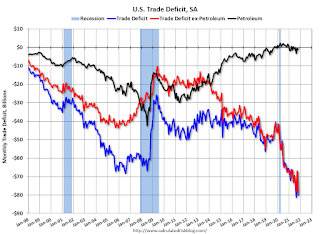 The blue line is the total deficit, and the black line is the petroleum deficit, and the red line is the trade deficit ex-petroleum products.
The blue line is the total deficit, and the black line is the petroleum deficit, and the red line is the trade deficit ex-petroleum products.Note that net, imports and exports of petroleum products are close to zero.
The trade deficit with China increased to $32.3 billion in November, from $30.6 billion in November 2020.
Weekly Initial Unemployment Claims Increase to 207,000
by Calculated Risk on 1/06/2022 08:34:00 AM
The DOL reported:
In the week ending January 1, the advance figure for seasonally adjusted initial claims was 207,000, an increase of 7,000 from the previous week's revised level. The previous week's level was revised up by 2,000 from 198,000 to 200,000. The 4-week moving average was 204,500, an increase of 4,750 from the previous week's revised average. The previous week's average was revised up by 500 from 199,250 to 199,750.The following graph shows the 4-week moving average of weekly claims since 1971.
emphasis added
 Click on graph for larger image.
Click on graph for larger image.The dashed line on the graph is the current 4-week average. The four-week average of weekly unemployment claims increased to 204,500.
The previous week was revised up.
Weekly claims were close to the consensus forecast.
Wednesday, January 05, 2022
Thursday: Unemployment Claims, Trade Deficit, ISM Services
by Calculated Risk on 1/05/2022 09:00:00 PM
Thursday:
• At 8:30 AM ET, The initial weekly unemployment claims report will be released. Initial claims were 198 thousand last week.
• At 8:30 AM, Trade Balance report for November from the Census Bureau. The consensus is the trade deficit to be $70.0 billion. The U.S. trade deficit was at $67.1 billion in October.
• At 10:00 AM, the ISM Services Index for December.
And on COVID (focus on hospitalizations and deaths):
| COVID Metrics | ||||
|---|---|---|---|---|
| Today | Week Ago | Goal | ||
| Percent fully Vaccinated | 62.3% | --- | ≥70.0%1 | |
| Fully Vaccinated (millions) | 206.8 | --- | ≥2321 | |
| New Cases per Day3🚩 | 554,328 | 281,842 | ≤5,0002 | |
| Hospitalized3🚩 | 85,423 | 64,152 | ≤3,0002 | |
| Deaths per Day3🚩 | 1,238 | 1,072 | ≤502 | |
| 1 Minimum to achieve "herd immunity" (estimated between 70% and 85%). 2my goals to stop daily posts, 37-day average for Cases, Currently Hospitalized, and Deaths 🚩 Increasing 7-day average week-over-week for Cases, Hospitalized, and Deaths ✅ Goal met. | ||||
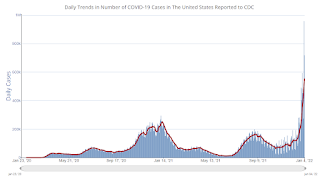 Click on graph for larger image.
Click on graph for larger image.This graph shows the daily (columns) and 7-day average (line) of positive tests reported.
Apartment Vacancy Rate Declined in Q4
by Calculated Risk on 1/05/2022 02:42:00 PM
Today, in the Calculated Risk Real Estate Newsletter: Apartment Vacancy Rate Declined in Q4
A brief excerpt:
Reis reported that the apartment vacancy rate was at 4.7% in Q4 2021, down from 4.8% in Q3, and down from a pandemic peak of 5.4% in Q1 2021.There is much more in the article. You can subscribe at https://calculatedrisk.substack.com/
This graph shows the apartment vacancy rate starting in 1980. (Annual rate before 1999, quarterly starting in 1999). Note: Reis is just for large cities.
Reis also reported the asking rents were up 2.8% in Q4 compared to Q3, and up 11.9% year-over-year. Rents were down year-over-year through Q2 2021 (due to the pandemic) and picked up sharply in Q3. Even with the recent surge in rents, rents are only up 4.5% annualized over the last 2 years (since rents decreased early in the pandemic).
Reis: Office Vacancy Rates Decreased Slightly in Q4
by Calculated Risk on 1/05/2022 01:46:00 PM
 Click on graph for larger image.
Click on graph for larger image.The first graph shows the office vacancy rate starting in 1980 (prior to 1999 the data is annual).
Reis also reported that office effective rents were unchanged in Q4; rents are about the same rate as early 2019.



